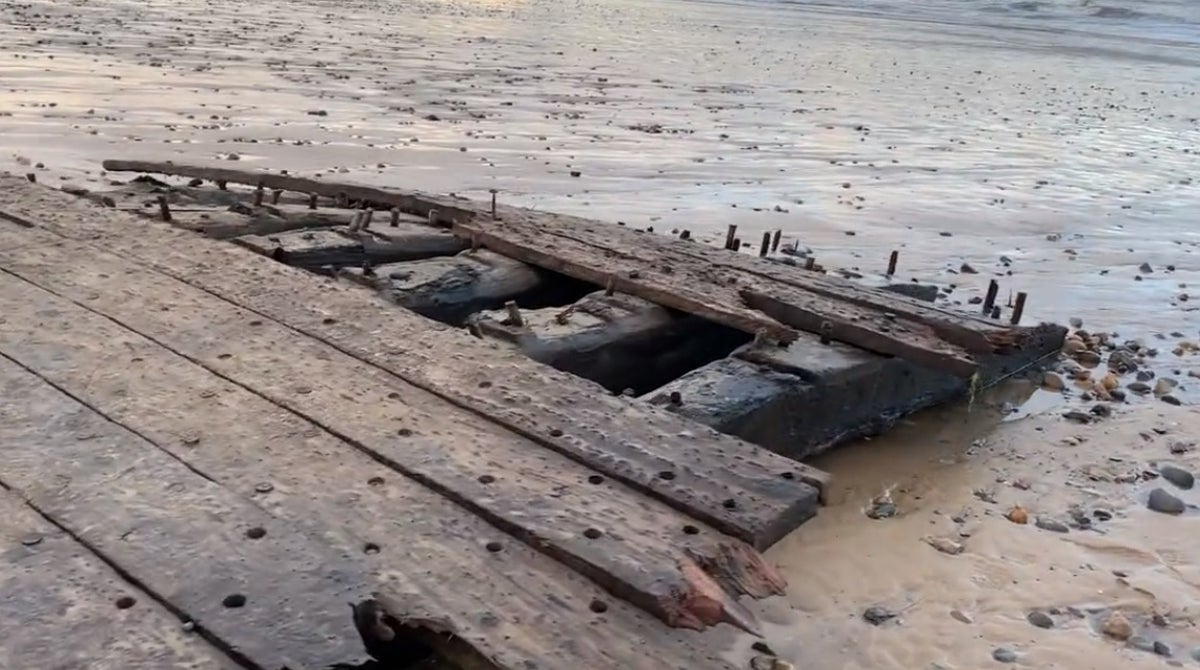
Storm Babet wreaked havoc across the UK over the weekend, causing deadly flooding and travel chaos for thousands.
But could the weather system, described by forecasters as “extraordinary”, also be responsible for uncovering a piece of history?
That is what some in Yorkshire believe after a large, wooden structure believed to be part of a 200-year-old boat washed up on the beach of Marske-by-the-Sea on Saturday.
Locals say the wooden frame could be part of the wrecked Whitby whaling boat The Esk, which was grounded just off the coast of Marske on 6 September 1826.
According to Heritage Gateway, which records historical information about England, the boat sank near a rock shoal called ‘The High’.
A report from the time said the vessel was homeward bound to Whitby, running before a storm, but was swept onto rocks and perished. All of those on board - apart from the master and one other man - died when the boat went under.
One person suggested the structure of the washed-up structure resembled The Esk.
Structure was found on the beach of Marske-by-the-Sea on Saturday— (X / Jackie Harrison)
“[The] shaped ribs [are] closely spaced and doubled-up,” the person wrote on Facebook.
“Also, two planks formed/narrower and thicker than the rest. The bottom of the hull close to the centreline? All wood construction, no sign of metal."
Historic England has said it is possible that the fragment may be part of The Esk. It plans to use dendrochronology, or tree-ring dating, to understand the felling date for the timbers used in the structure that washed up on the beach to determine what ship it might belong to.
There are records for at least 23 historic wooden wrecks located in the area which may be linked to this fragment, with possibly many more unreported wrecks from before the mid-18th century.
A Historic England spokesperson said: “Following the recent storms, part of the hull of a wooden shipwreck has appeared on the beach near Marske-on-Sea. This is a region noted both for its tradition of maritime industry and seafaring, but also the dangers of such work in the age of sail.
“Through historic research, recording the modes of construction, and using the latest scientific dating Historic England hopes to reveal more information about the ship this fragment came from, including when it was built and possibly linking this to a known historic shipwreck event.”
While Storm Babet has passed, parts of the country have continued to see miserable weather and rain this week. Heavy rain continued overnight on Tuesday and three weather warnings have been issued for parts of Scotland up until Saturday, which could bring travel disruption.
Over the weekend, a total of 13 areas broke their daily rainfall records for October last week, including sites in Suffolk, South Yorkshire, Lincolnshire, Wiltshire, Kincardineshire, North Yorkshire, Nottinghamshire, Northumberland, Derbyshire and Humberside, the Met Office said
Reports of floods to the Environment Agency (EA) reached the highest level since 2015/16 at the peak of Storm Babet, environment minister Rebecca Pow told the Commons on Monday.
The EA issued more than 300 flood warnings and received more than 1,800 calls to its flood line, she said.
Hundreds of people have been left homeless in the wake of Storm Babet, with about 1,250 properties in England flooded, according to the EA.
Some of those affected in Retford, Nottinghamshire, were angered by a “lack of action” to protect their homes, with one resident describing a visit by the environment secretary Therese Coffey on Monday as an attempt to “polish her halo”.
The death toll from incidents linked to Storm Babet rose to eight on Monday as police recovered the body of a man after reports that a person was trapped in a vehicle in floodwater near Marykirk, Aberdeenshire, on Friday.







